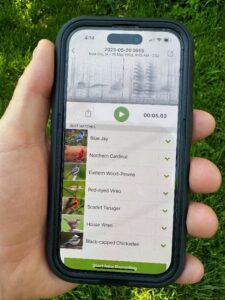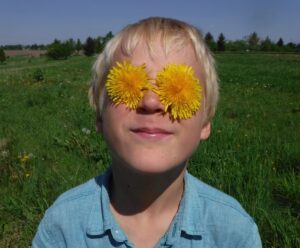 Not surprisingly, I am late to the game of nature apps. An important part of Taproot is freeing us from our screens. I recently downloaded the Merlin app, from the Cornell Lab of Ornithology, which tells you which birds are singing in the vicinity. It’s a lot of fun! But I quickly noticed that as I was walking down the Hickory Hill path, instead of searching the canopy for the singers, my eyes were focused on my phone, eagerly waiting for more species to pop up in the list. That didn’t seem very good. I was gaining knowledge–I hadn’t known there was a scarlet tanager nearby! But I was getting it from my phone instead of from my own observation and skill.
Not surprisingly, I am late to the game of nature apps. An important part of Taproot is freeing us from our screens. I recently downloaded the Merlin app, from the Cornell Lab of Ornithology, which tells you which birds are singing in the vicinity. It’s a lot of fun! But I quickly noticed that as I was walking down the Hickory Hill path, instead of searching the canopy for the singers, my eyes were focused on my phone, eagerly waiting for more species to pop up in the list. That didn’t seem very good. I was gaining knowledge–I hadn’t known there was a scarlet tanager nearby! But I was getting it from my phone instead of from my own observation and skill.
With your smartphone and a few apps, you essentially have a comprehensive guide to all animals, plants, fungi, rocks, minerals, clouds, stars, tracks, and even turds, right at your fingertips. Does this enrich and strengthen our connection to the earth, or does it dilute, outsource, and ultimately weaken it? As with most everything, the answers probably lie somewhere in the middle.
My minimal interaction with nature apps has me intrigued, but my instincts still  urge caution. For many of us, our exercise, food, school work, sleep, social interactions, and other aspects of life are mediated, tracked, analyzed and planned by apps, and we’ve grown physically and emotionally more dependent on our phones all the time (If I’m not carrying my phone or wearing my gadget, do those steps actually happen?) It’s tempting to work these technologies into the Taproot routine, but should our connection with nature follow this trend as well? I’m still open to the possible benefits of nature apps, but for the time being, we will maintain Taproot as a refuge for children to connect their eyes, ears, and bodies to the sights, sounds, and feelings of real life, independent of our digital mediators.
urge caution. For many of us, our exercise, food, school work, sleep, social interactions, and other aspects of life are mediated, tracked, analyzed and planned by apps, and we’ve grown physically and emotionally more dependent on our phones all the time (If I’m not carrying my phone or wearing my gadget, do those steps actually happen?) It’s tempting to work these technologies into the Taproot routine, but should our connection with nature follow this trend as well? I’m still open to the possible benefits of nature apps, but for the time being, we will maintain Taproot as a refuge for children to connect their eyes, ears, and bodies to the sights, sounds, and feelings of real life, independent of our digital mediators.